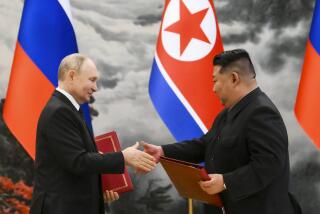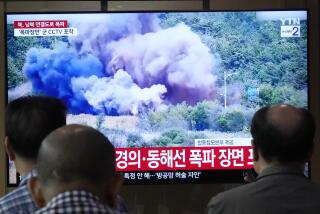North Korea fires on South Korean island
Reporting from Seoul — North Korea on Tuesday fired dozens of artillery rounds onto a populated South Korean island, killing two and injuring 19 others after Pyongyang claimed that Seoul was readying for “an invasion,” officials said.
South Korean President Lee Myung-bak called an emergency session of his national security-related ministers in an underground bunker at the presidential residence late Tuesday to devise a response to the attack, which occurred near the disputed western border between North and South.
The Seoul government later called North Korea’s artillery attack a “clear military provocation” and warned that the secretive regime would face “stern retaliation” should it launch further attacks.
Hong Sang-pyo, senior secretary for public affairs at the presidential office added that “recklessly shelling mere civilians can never be tolerated. North Korea will have to bear full responsibility” for the attack.
The South Korean military was placed on high alert, with fighter jets sent into the air, after officials confirmed that two South Korean marines were killed and 19 others -- including three civilians -- were injured.
South Korean soldiers returned fire, but it was not clear whether any North Koreans were killed or injured.
The South Korean military was conducting drills near Yeonpyeong island when the North opened fire about 2:30 p.m., officials said. Pyongyang had earlier sent messages to Seoul that it considered the exercises “preparation for an invasion,” which South Korea denied, officials said.
Twenty minutes after the attack, the South Korean military returned fire and raised security alerts to their highest non-wartime levels. Just after 3 p.m., North Korea again began firing artillery from cliffside command posts less than 10 miles to the north.
Just before 4 p.m., South Korean military officials sent a message demanding a cease-fire, officials said.
Lee said he was trying to prevent the exchange of artillery fire between North and South Korea from escalating into a greater conflict, the Yonhap news agency reported.
In a statement, the South Korean Joint Chiefs of Staff said, “The North’s firing comes as the South Korean forces conducted a routine drill in waters near the island.”
A spokeswoman for Lee said the Seoul government was looking into the motive behind the sudden attacks.
“Our navy was conducting a maritime exercise near the western sea border today. North Korea has sent a letter of protest over the drill. We’re examining a possible link between the protest and the artillery attack,” said Kim Hee-jung, the spokeswoman.
The White House late Tuesday said the U.S. would stand by South Korea. “Earlier today North Korea conducted an artillery attack against the South Korean island of Yeonpyeong. We are in close and continuing contact with our Korean allies,” said a statement.
“The United States strongly condemns this attack and calls on North Korea to halt its belligerent action and to fully abide by the terms of the Armistice Agreement.” It added that the U.S. “is firmly committed to the defense of our ally, the Republic of Korea, and to the maintenance of regional peace and stability.”
Stephen Bosworth, the U.S. special envoy to North Korea, was in China on Tuesday with South Korea’s chief nuclear negotiator, Wi Sung-lac, to meet with officials in Beijing. After news of the attack, officials canceled a scheduled news conference until Wednesday morning.
The Chinese Foreign Ministry on Tuesday said it would have to confirm the circumstances of the attack.
“We are concerned about the issue, and the real situation needs to be confirmed, said spokesman Hong Lei.
Still, a leading Chinese scholar signaled that China would be reluctant to intervene.
“Why China? This is clearly an issue between North and South Korea,” said Piao Jianyi, chief of the Center of Korean Peninsula Studies at the Chinese Academy of Social Sciences.
In any case, he said, “things are not clear. We should wait to hear what North Korea has to say and what South Korea is going to do. Maybe South Korea had a military exercise recently.”
He did acknowledge that the situation could be more serious than the sinking of the Cheonan, the South Korean patrol ship that went down in March, killing 46 crewmembers: “I wouldn’t compare it to the incident in March. That was more complicated. North Korea said they weren’t responsible and South Korea said they were. In this incident, clearly North Korea did it.”
Analysts in South Korea said tensions in recent months had reached the breaking point.
“The artillery fire stems from mistrust between the South and North Korean militaries,” said Yang Moo-jin, professor at the University of North Korean Studies in Seoul.
“The continued hostile relations have escalated to this tension. Seoul has maintained that the drill near the island is a routine exercise, while Pyongyang claims it’s a precursor to an invasion.”
TV stations interrupted regular programming to interview eyewitnesses on Yeonpyeong island, where flames caused by exploding shells were moving toward houses, several of which were also on fire.
It was not clear whether the structures suffered a direct hit.
Officials said hundreds of the 1,300 people who live on the island were evacuated to the South Korean mainland.
Seoul officials said they would investigate the economic effect of the attack, which caused the South Korean won to drop in value against the U.S. dollar Tuesday.
Famous for crab fishing and naval skirmishes, Yeonpyeong lies less than two miles from North Korean waters, just inside the disputed maritime boundary known as the Northern Limit Line.
North Korea has never accepted the boundary and has engaged over the years in frequent provocations around the island. In 2002, a North Korean ship penetrated the waters, resulting in a clash that killed six South Korean sailors and about 13 North Koreans.
Kim is a researcher in The Times’ Seoul bureau. Barbara Demick contributed to this story from Beijing.
More to Read
Sign up for Essential California
The most important California stories and recommendations in your inbox every morning.
You may occasionally receive promotional content from the Los Angeles Times.











